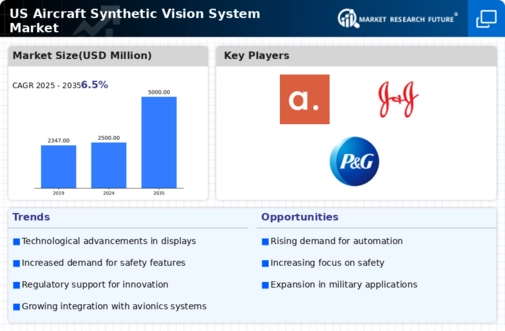The aircraft synthetic vision system market is characterized by a dynamic competitive landscape, driven by technological advancements and increasing demand for enhanced safety features in aviation. Key players such as Garmin (US), Honeywell (US), and Rockwell Collins (US) are at the forefront, each adopting distinct strategies to solidify their market positions. Garmin (US) emphasizes innovation in its product offerings, focusing on integrating advanced features such as augmented reality into its synthetic vision systems. Meanwhile, Honeywell (US) has been pursuing strategic partnerships to enhance its technological capabilities, thereby expanding its market reach. Rockwell Collins (US), on the other hand, has concentrated on mergers and acquisitions to bolster its portfolio, indicating a trend towards consolidation in the market.
The business tactics employed by these companies reflect a concerted effort to optimize supply chains and localize manufacturing processes. The market appears moderately fragmented, with a mix of established players and emerging entrants. This competitive structure allows for a diverse range of offerings, although the influence of major companies remains substantial, shaping industry standards and customer expectations.
In November 2025, Garmin (US) announced the launch of its latest synthetic vision system, which incorporates machine learning algorithms to enhance terrain awareness and obstacle detection. This strategic move not only showcases Garmin's commitment to innovation but also positions the company to meet the growing demand for advanced safety features in aviation. The integration of AI into their systems is likely to set a new benchmark for competitors, emphasizing the importance of technological advancement in maintaining market leadership.
In October 2025, Honeywell (US) entered into a partnership with a leading aerospace technology firm to co-develop next-generation synthetic vision systems. This collaboration is expected to leverage both companies' strengths, enhancing product capabilities and accelerating time-to-market. Such strategic alliances are indicative of a broader trend in the industry, where collaboration is increasingly viewed as a means to drive innovation and improve competitive positioning.
In September 2025, Rockwell Collins (US) completed the acquisition of a smaller tech firm specializing in AI-driven navigation solutions. This acquisition is significant as it not only expands Rockwell Collins' technological capabilities but also enhances its competitive edge in the synthetic vision system market. The move reflects a growing trend towards integrating AI and machine learning into aviation technologies, which is likely to redefine operational efficiencies and safety standards.
As of December 2025, the competitive trends in the aircraft synthetic vision system market are heavily influenced by digitalization, sustainability, and AI integration. Companies are increasingly forming strategic alliances to enhance their technological capabilities and market presence. The shift from price-based competition to a focus on innovation and supply chain reliability is evident, suggesting that future competitive differentiation will hinge on the ability to deliver cutting-edge technology and sustainable solutions.














Leave a Comment